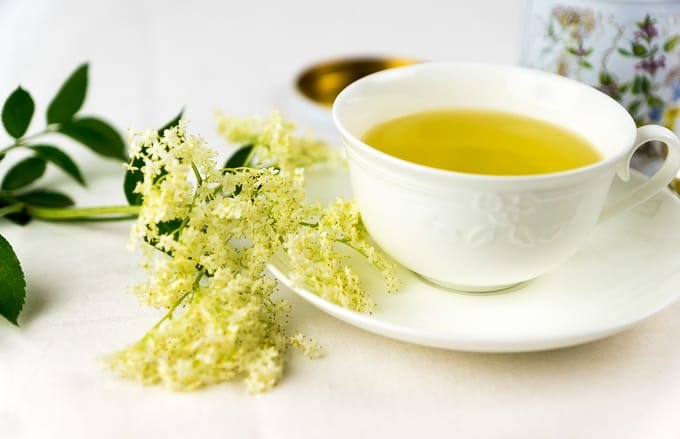
Spring is here, and so are the fragrant elderflowers! Elderflower tea isn’t just tasty—it’s loaded with health benefits. Keep reading for a simple recipe, tips on harvesting and drying, and all the wonderful elderflower benefits.
Note: Some of the links below are affiliate links. At no additional cost to you, I may earn a small commission if you purchase through those links. You can read my full affiliate disclosure here.
In This Post:
The merry month of May is delighting us with a burst of colors—countless shades of green and the charming hues of blooming trees and flowers.
And perfumes, oh, all the lovely scents when passing by lilac trees, honeysuckle, roses, mock orange blossoms, and elderflower blooms. I love them all, but I have a soft spot for those wild flowers that are not just beautiful but also edible, like lilacs and elderflowers. Right now in Germany, the lilac season has just ended, but I don’t have time to be sad because the elderflower bushes are in full bloom. The happy harvesting and indulging in sweet, heady scents continues.
Elderflowers feel wonderfully familiar to me, as no spring went by in my Romanian childhood without sipping on the delicious suc de soc—a refreshing elderflower lemonade. Sweet, yummy drinks are exactly what elderflowers are mainly known for, like cordials, lemonades, syrups, and the Hugo cocktail. If you're interested, I have an easy recipe for elderflower syrup.
It’s a bit of a shame, though, that elderflower tea isn’t as popular (yet), given how beneficial it is. Plus, it’s floral, delicious, and velvety—everything you’d want from a soothing cup of tea.
Benefits of Elderflower Tea
I like sipping elderflower tea in the evenings—it soothes both my mind and stomach. But beyond its calming effects, elderflower tea boasts more health benefits that have been known (and appreciated) for centuries.
Elderflower tea is also said to:
- Immune Support: Elderflower is loaded with antioxidants (like flavonoids and vitamin C), which can help boost your immune system.
- Respiratory Health: People have been using elderflower tea for ages to help with symptoms of colds and flu (like stuffy noses and scratchy throats).
- Digestive Aid: If you ever feel bloated or just off after a meal, elderflower tea might help.
- Detoxification: Some say elderflowers can help purify the blood and keep your kidneys happy.
- Metabolic Support: Apparently, elderflower might even support your metabolism by promoting insulin secretion and glucose management.
You can explore more about the various health benefits of elderflowers over at Herbal Reality and Health.com.
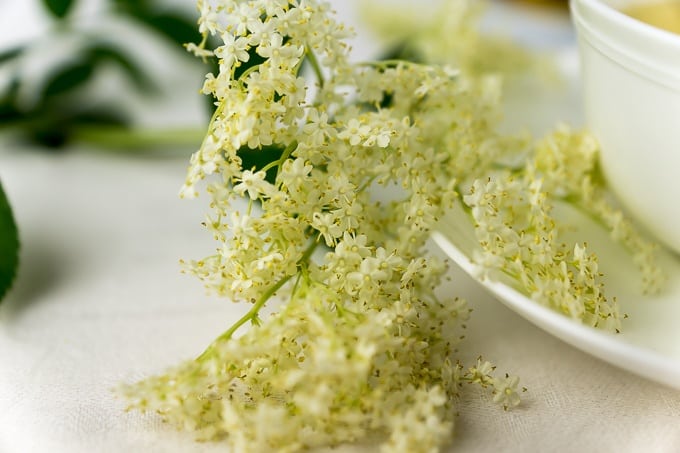
Recommendations for Harvesting Elderflowers
First things first: Make sure you’re actually picking elderflowers and not something else entirely. They can be easily confused with cow parsley, pyracantha, or cowbane (which is poisonous!). Remember, elderflowers grow on bushes, not on the ground. Their scent is intense, sweet, and summery, and their color is a creamy white—not stark white.
When to Harvest
The best time to pick elderflowers is around noon on a sunny day. The warmth really brings out their heady, floral aroma.
How to Choose the Right Flowers
- Look for flower heads that are fully open and fresh, with no brown or withered blooms.
- After picking, give them a gentle shake to get rid of dust and any little critters. This is key because washing them later would strip away a lot of their lovely aroma.
- Avoid flowers growing right by the roadside—they could be covered in petrol fumes.
Harvest Responsibly
- Never strip a single bush of all its flowers. Instead, gather from different plants to allow them to thrive and bear elderberries later in the year.
- Use a basket or a paper bag for collecting—plastic bags trap moisture, and elderflowers need to breathe. If you have to use plastic, at least keep it open.
After Harvesting
- Use the flowers as soon as possible—they wilt fast and lose their fragrance. You can also dry them for later use.
- A quick note of caution: Some parts of the elderberry bush (like the leaves, bark, and unripe berries) are toxic. Stick to the flowers!
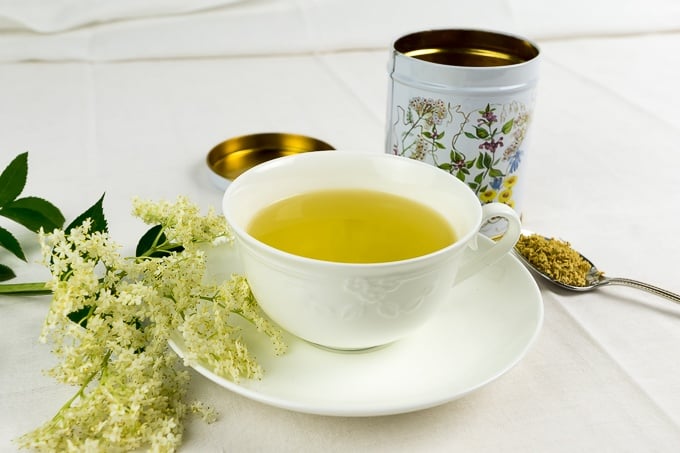
How to Dry Elderflowers
I love drying elderflowers so I can enjoy their flavor long after the season’s over—perfect for whenever I’m craving a cup of tea.
Drying them is easy. Just spread the flower heads out on some paper or kitchen towels. Make sure they’re in a warm, dry, and shady spot (direct sunlight can make them lose their color and aroma). Leave them there until they’re completely dry and crispy.
Once they’re ready, store them in an airtight container, and you’re good to go!
I told you, it's super easy to stock up on elderflower tea for the winter. But if your stash runs out and you're craving a cup, you can always buy it. You can even find organic elderflower tea on Amazon.
Elderflower Tea Recipe
Here’s how to make this lovely, soothing tea, whether you’re using freshly picked elderflowers or dried blossoms. This recipe makes two cups.
In a teapot, steep 4 fresh elderflower heads (or 2 teaspoons of dried blossoms) in two cups of boiling hot water for about 5 minutes. I like to cover the pot while it steeps as it helps trap all those delicate aromas and beneficial compounds.
That’s it! Pour into your favorite cup and enjoy.

I’m always curious. How did it go? Tried the elderflower tea recipe? I wanna hear all about it. How did you like it? Drop the details below because we all love a good kitchen win or a lesson learned.
Wishing you planty of tea sipping delights,
Ramona
♥

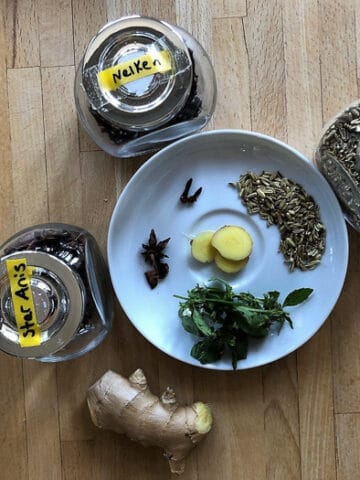
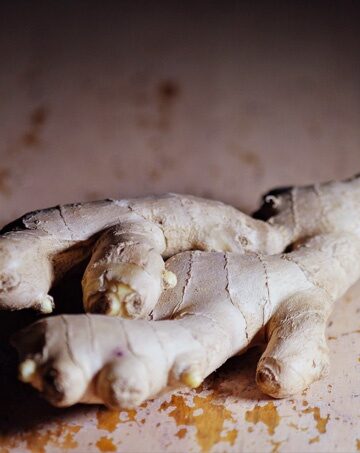
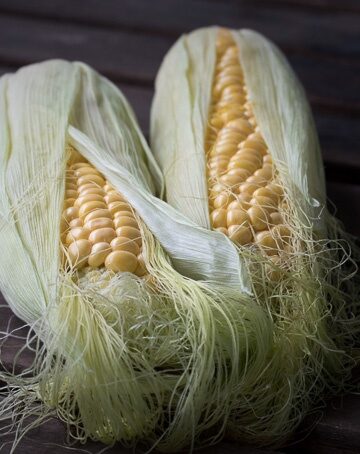
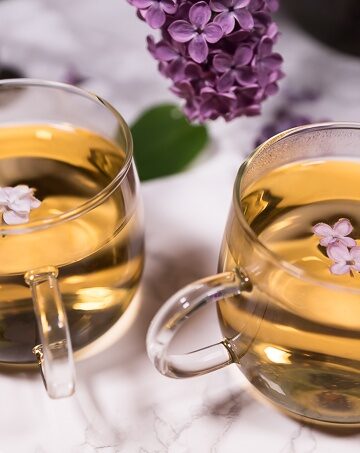
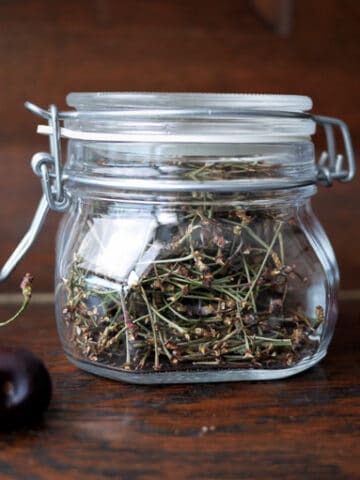

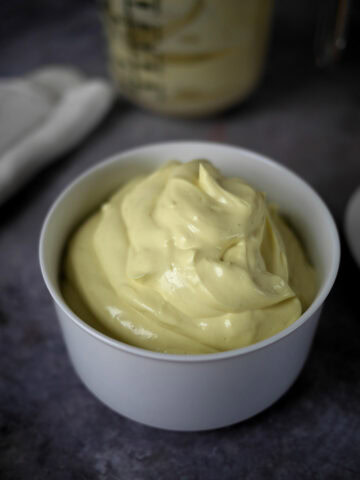

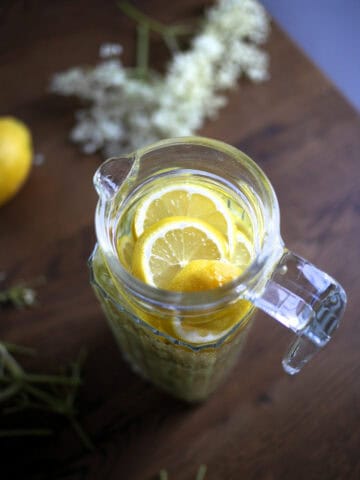
TobyLauren says
Can this be done with red elder as well? I don't have blue elder growing in my area, but we do have red elder. I've heard mixed reviews.
Ramona says
Thanks for bringing up this topic. I'm only familiar with black elder, and read mixed reviews concerning red elder as well. As far as I understand, it's been used similar to black and blue elder, but the red elderflowers can cause digestive discomfort to some people. Unfortunately, I'm not a botanist or herbalist - but you might want to turn to one if you want to play it safe.
Here is more information on red elder:
https://thefatofthelandblog.wordpress.com/tag/red-elderflower/
http://nativeplantspnw.com/red-elderberry-sambucus-racemosa/
Swantje M. Harvey says
Hi! I finally have plenty Elder in my backyard and found a spot again in the area,after my old familiar one had been cleared for construction. Have always just made syrup and some jelly. Just now, I had to decide to cut back some.because my Okra was not getting enough light and decided to see what to do with the blossoms,which are in full bloom.Also, I often see Elders in bloom in the wild in May,but come August when they are ripe,the lots are too overgrown for little old me to risk foraging into.After reading your advice here,I will go there this week and get googobs of them.Since I live in humid Louisiana in a small house with very little sprawl-out surface,would it be okay to use my dehydrators?
Ramona says
Dear Swantje, thanks a lot for your lovely comment, I enjoyed reading about your garden in Louisiana - how gorgeous that you have such an abundance of Elder blooms and Okra (and probably lots of other produce).
As to your question: I've never used a dehydrator before, but my oven on the lowest heat possible for dehydrating fruit (apple slices, apple peal, etc.). This worked out nicely. I can imagine that you can dehydrate blossoms in the same way, be it in the oven or the dehydrator. As blooms and blossoms are more delicate and less "juicy" compared to fruit slices, I think that they will be quicker to dehydrate as fruit slices.
Wishing you lots of fun foraging.
Yasmin Stephens says
1 Elderflower tea is from non native Sambucus nigra? Correct?
2 Question can i make tea from the native sambucus canadensis? Or not?
Ramona says
Dear Yasmin,
Thank you for your questions! For me at least, the black elderberry (Sambucus nigra) is the most readily available variety here in Germany. While I'm not a botanist or herbalist, from what I've read in these sources, the blooms from Sambucus canadensis can be used in similar ways as those from Sambucus nigra:
https://en.wikipedia.org/wiki/Sambucus_canadensis
https://plants.ces.ncsu.edu/plants/sambucus-canadensis
Margaret Henry says
Wow I have so many wild elderflowers this year. Besides drying them what else can I do with them? TY!
Ramona says
Congrats on the elderflower bounty, I can imagine the gorgeous scents.
You could make Romanian sparkly lemonade, elderflower fritters, or elderflower cordial/syrup.